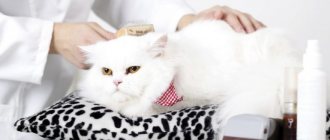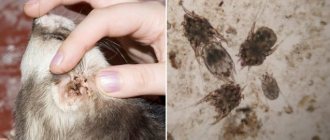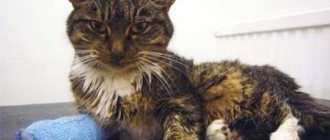Paresis of the hind limbs in cats is considered one of the most severe and dangerous conditions. The disease can also affect other parts of the body and is accompanied by partial or complete loss of movement, excessive salivation, and breathing problems. At the first symptoms of deterioration in the pet’s health, the owner should contact a veterinarian, who will prescribe treatment and rehabilitation exercises, and give preventive recommendations.
According to veterinarians, most often paraparesis develops after a fall from a window, when the cat receives a spinal injury due to the carelessness of the owner.
Causes of paralysis in cats
Almost all diseases of cats can lead to a deterioration in their condition with the occurrence of paralysis.
This even applies to ear scabies, in which the middle ear first becomes inflamed, then the infection spreads to the inner ear. Further, the membranes of the brain may be affected. It is the latter condition that becomes a threat of paralysis. The main causes of paralysis in cats are:
- spinal injury;
- inflammatory processes of the spine;
- fibrocartilaginous embolism;
- stroke;
- damage by ixodid ticks;
- viral infection (eg fip);
- gas poisoning.
If a cat falls from a height, it can damage the spinal cord and vertebrae. Depending on the location of the lesion, paralysis of the front and hind limbs occurs, but mostly both are affected. Signs appear unexpectedly, often increasing in a short time. Inflammatory processes of the spinal cord occur during poisoning, complicated trauma, damage by parasites and infectious processes.
Important!
During a stroke, the blood vessels of the brain are affected. This pathology leads to disruption of the functioning of this organ and motor function, up to and including paralysis.
If a cat has a fibrocartilaginous embolism, in which blood circulation is disrupted, a sudden decrease in blood supply to tissues may occur, followed by necrosis. The disruption is caused by blockage of blood vessels with pieces:
- tumors;
- blood;
- fat
6 days after being bitten by ixodid ticks, tick paralysis often occurs due to the toxins they secrete. A dangerous viral infection like rabies can also lead to paralysis. Most often the larynx is affected, causing breathing to stop.
Postpartum paresis
This type must be considered separately. The second name is postpartum hypocalcemia . Occurs during severe “calcium starvation” in females who have just given birth (no later than three to four days after birth). The more kittens in the litter, the higher the risk of complications. For the same reasons, the risk of postpartum paresis is always higher in miniature cats. And for the same reasons, their diet before and during pregnancy should be closely monitored.
Kinds
There are several types of paralysis.
They characterize the degree of the disease. With hemiplegia, damage occurs to the pelvic and thoracic region. In this case, the paws on one side are paralyzed. A symmetrical lesion also occurs, which is called paraplegia. Then paralysis of both lower extremities develops simultaneously.
In monoplegia, only one paw is affected. And with tetraplegia, all four limbs are completely paralyzed.
This disease is divided according to the area covered, namely paralysis:
- larynx;
- spinal;
- hind limbs (may be ascending if it moves to the forelimbs);
- facial nerve.
When the hind limbs are paralyzed, only their functions are impaired, while the front limbs remain healthy. If a cat has an injury to the radial nerve, on which the mobility of the front legs depends, then paralysis may well develop.
There are paralysis (immobility) and paresis (weakening) of the limbs. Paralysis may occur suddenly, or may develop as a result of paresis. Paresis, in turn, can also occur suddenly, or it may be preceded by some symptoms.
Signs that the paws are failing: - wobbling of the hind limbs, unsteadiness in gait. - dragging, dragging paws. The cat moves its hind legs without lifting them from the floor. - frequent squats, the cat’s hind limbs move apart.
If these signs are observed in small kittens that are still learning to walk, then this, of course, is not a sign of a disease. These are natural causes and do not require treatment.
Most often in clinical practice, we observe sudden failure of the hind legs in cats, without any warning signs. A cat crawling on its front legs with its hind limbs dragging behind it greatly frightens its owners. In fact, this condition really indicates a serious problem. Sometimes insoluble. It is also good if the cat does not stand on its paws, but feels them and experiences pain when its toes are irritated. It’s really bad when a cat doesn’t stand on its paws and doesn’t feel them at all.
The main causes of hind leg failure in cats: 1. Mechanical traumatic injuries to the spine. 2. Thromboembolism of the arteries of the extremities. 3. Acute neurological disorders of the brain. 4. Tumor diseases. 5. Inflammation of the spinal cord or brain. 6. Acute poisoning.
As we see, there are several reasons for hind limb failure in cats, but all of them are quite serious. Let's look at each point in more detail.
1. Spinal injuries. In cats, with a fracture, dislocation of the spine, or severe contusion of the spinal cord, a post-traumatic reaction often occurs - the hind legs are taken away. Paw paralysis may be accompanied by painful shock, loss of consciousness, and fecal and urinary incontinence. Damage to the spinal cord can occur as a result of an animal falling from a height, biting, or a strong blow. Moreover, the closer the injury is to the head, the more severe the consequences. Thus, damage to the cervical region can lead to paralysis of the entire torso and limbs, and damage to the pelvis can only lead to paralysis of the tail. Most often the spine is damaged in the thoracolumbar region. With such an injury, paralysis of the hind limbs occurs, and the front legs and head fully retain their functions. The diagnosis is made based on the clinical picture and radiographic examination. With closed injuries, the spinal cord can be compressed by edema or hematoma - in this case, with proper treatment and the absence of complications, the animal’s condition is usually reversible and after restoration of nerve conduction, paw sensitivity and motor functions gradually return. The scope and appropriateness of treatment measures are prescribed by a veterinarian. In different situations, both conservative and surgical assistance are possible. There are situations when any conceivable measure has an unfavorable prognosis. This happens, for example, with spinal cord ruptures, irreversible damage, myelomalacia or necrosis.
2. Arterial thromboembolism (ischemic neuromyopathy). This is a very dangerous condition that occurs when the femoral artery is blocked by a blood clot. In such a situation, the cat experiences severe pain in the lumbar region and is unable to rise on its hind legs. Symptoms develop very acutely: the animal screams in pain, is agitated, drags its paws behind it, there is no femoral pulse, the paw pads turn blue and cold, and there is often a rapid heartbeat and open-mouth breathing. There are several reasons for the development of this pathology. Most often, this is a consequence of a heart disease called hypertrophic cardiomyopathy (HCCM). This heart pathology leading to heart failure is especially common in cat breeds such as Maine Coon, Ragdoll, Sphynx, British and Scottish Fold. But embolism can also occur for the following reasons: in septic and shock conditions; as a result of injuries and bleeding; after major surgical interventions; with tumor processes in the abdominal cavity; as a result of transfusion of incompatible blood; for acute poisoning; and develop for iatrogenic reasons. I would like to especially highlight the last point - iatrogenic pathology. This is the development of thromboembolism with inadequate use of drugs that increase blood clotting, leading to hypercoagulation. For example, they treated cystitis, there was blood in the urine, and they took Vicasol, Dicinone, aminocaproic acid, rutin for a long time, and, as a complication, they received thromboembolism. Such drugs should be taken under the supervision of a doctor! The prognosis for thromboembolism is cautious towards unfavorable. Treatment, including surgery, must begin immediately. Initially, vasodilators, hormones, and antioxidants are prescribed. In parallel, an infusion of high molecular weight solutions is carried out. Fibrinolytics, thrombolytics and anticoagulants are immediately administered. If conservative treatment does not produce results within 8 hours, then surgery is indicated. It also does not always give a positive result, but it is the only way out. Due to the severity of the pathology, death after blockage of the artery can occur within 12-18 hours. Therefore, if drug therapy does not produce quick positive results, then there is nothing to lose.
3. Acute disorders of cerebral blood supply. Stroke. These are conditions in which the brain. or its area, does not receive enough blood, which causes a sharp deterioration and disruption of its functioning. The main symptoms of acute disturbance of cerebral blood supply: unnatural position of the head; impaired balance and coordination; deterioration of vision up to blindness; involuntary urination and defecation; uncontrolled movement of the pupils and eyeballs; refusal to eat; fainting; convulsions; partial paralysis; memory loss and "eccentricity". It is believed that the causes of strokes and cerebrovascular accidents in cats are completely different from those in humans. If in humans the main cause of strokes is a rupture or blockage of a vessel in the head, then in cats the main causes are as follows: head injuries; poisoning with strong toxins, including rat poison; prolonged fever; severe stress. Due to the fact that the brain of animals has a small mass and does not have clearly defined functional zones, a stroke is more easily tolerated in them. However, with serious brain damage, rapid death is possible. But if death does not occur within 24 hours after the onset of initial symptoms and the animal’s condition does not worsen, then there is every chance of improving the situation. Treatment of the pathology is complex. The primary treatment plan involves eliminating the causes that caused the disruption of cerebral blood supply. At the same time, anti-inflammatory and decongestant drugs, antibiotics, antihypoxants, sedatives, anticonvulsants and antiemetic drugs are used. All drugs are carefully and over a long period of time introduced into the dropper. During treatment, the patient must be under the supervision of doctors. Typically, stabilization of the patient takes 1-2 days. In situations of exacerbation of the situation, a transition to intensive care is possible - an oxygen chamber, controlled hypotension and coma. The prognosis for brain disorders is always cautious, especially in older animals. According to statistics, acute disorders of cerebral blood supply and stroke are not a common cause of limb failure in cats.
4. Tumors. The variety of tumor diseases that can cause limb failure is quite large. For example, these could be spinal tumors that can compress the spinal cord and cause neurological deficits. These can be giant abdominal tumors that can disrupt the blood supply to the trunk and limbs and cause thromboembolism or stroke. These could be tumors of the brain or spinal cord that can compress or destroy areas of contact healthy nerve tissue, thereby disrupting the conductivity of the latter. In the end, these may also be oncological problems not directly related to the blood vessels and brain, for example, disseminated lung cancer or osteosarcoma of the bones. Malignant widespread tumor processes in the body lead to its general poisoning. And chronic increasing intoxication can lead to the same symptom complex - impaired cerebral blood supply, thromboembolism, etc., and as a result - limb failure. Due to the diversity of tumor diseases and the versatility of the consequences caused by them, each case of limb failure due to oncological processes is individual. Prognosis, the possibility of treatment, consequences - all this is decided by the attending physician. In difficult cases, the decision is made collegiately - by a group of doctors. The percentage of limb failure due to tumor diseases is small. But we should not forget that oncology itself consistently ranks second among the causes of overall mortality in domestic animals. Moreover, there are many orthopedic diseases that are caused by cancer. They begin with slight pain or lameness on the paw, but if not diagnosed in a timely manner, they can quickly lead to death. Only a periodic preventive examination by a veterinarian will help to timely diagnose and treat such a terrible disease of our time as oncology.
5. Inflammation of the brain or spinal cord. Myelitis can occur as a result of blood poisoning, helminthic infestations, poisoning with heavy metal salts, as a result of aggressive drug effects on the body, trauma or autoimmune reactions. Inflammation of the spinal cord is also possible as a complication after epidural anesthesia or myelography. Treatment in these situations is aimed at eliminating the factor or factors that caused the inflammation. In cases of septic tissue damage to the brain or spinal cord, when the nerve tissue is inflamed due to microbial invasion, treatment is carried out with a group of special antibiotics. The fact is that not all antimicrobial drugs are able to penetrate the blood-brain barrier, that is, penetrate the brain. An incorrectly selected antibiotic will not have an effect on the microbe that destroys the brain. Therefore, it is very important before starting treatment for myelitis to decide on its type - aseptic or septic. That is, microbial or germ-free. Correctly and timely treatment usually has a positive result. The only exceptions may be elderly animals. In them, as a rule, due to age-related changes in the body, recovery may not be complete.
6. Poisoning. Acute or chronic intoxication can cause all of the above-mentioned causes leading to limb failure: thromboembolism, acute cerebral disorders, stroke, inflammation of the meninges. Acute poisoning with timely assistance usually gives a positive result. Treatment is aimed at evacuating poison from the body, preventing its penetration into the body and removing poison that has already entered the body. The treatment protocol for each case of poisoning is individual, but usually includes intravenous drips, forced diuresis, and the administration of antidotes and symptomatic agents. It is important to remember about the timeliness of assistance. After all, the poison is so strong that it could partially paralyze the nervous system. Chronic poisoning is much more insidious. After all, nervous tissue has been attacked by neurogenic poisons for a long time, which led to a partial loss of its functions and paralysis. As a rule, chronic poisoning is small but constant amounts of poison entering the body. For example, this happens with tumor diseases, with the constant administration of potent drugs, with improper feeding. The prognosis in such cases is cautious and often unfavorable. Treatment is often not effective enough.
IMPORTANT: — Herniated discs in cats almost never cause paralysis of the limbs. If in dogs discopathy, hernias and extrusions of spinal discs are the main cause of paw failure, then in cats the same diseases do not cause similar symptoms. Intervertebral hernias in cats usually manifest only as increased pain in the spinal column, gait disturbance and meteopathic syndrome. Paralysis of the hind legs in cats can only occur with obvious spinal injury: displacement, rupture, closed hematoma, etc. — Renal colic and urolithiasis cannot cause limb failure. These diseases can only cause severe pain, but not paralysis of the paws. — Stormy heat in cats with dragging hind legs does NOT lead to paralysis. This only indicates a very high desire to mate. If a cat is constantly “empty,” that is, her estrus does not end with pregnancy, this, of course, also undermines her health, it is recommended to sterilize such animals.
Doctor of Veterinary Medicine M. Shelyakov
Symptoms
Sometimes at the initial stage of the disease the only sign is uncertain and unsteady movements. The animal tries to lie down as much as possible rather than walk.
Other symptoms that indicate paralysis is developing in a cat are conditions in which it:
- refuses to eat;
- cannot eat - food falls out of mouth;
- unable to hold head up;
- stops washing.
Sometimes you can observe an involuntary leakage from an animal:
- saliva;
- feces;
- urine.
Important!
It is noted that with paralysis, some cats try to crawl somewhere, show aggression, scratch and bite. Others become lethargic, sleepy, and unresponsive to the presence of their owners. Animals' pupils dilate.
In diseased limbs due to injuries or diseases due to thrombosis, hernia and damage to nerve endings, the following may be observed:
- cold snap;
- absence or decreased pulse;
- bluishness of the skin.
Possible complications and consequences of paralysis
The most common (and almost always fatal) complication is aspiration pneumonia. Since a diseased larynx can no longer separate the flow of food and air, food often enters the lungs and begins to rot there. Even in cases of timely treatment, the risk of death is very high.
A cat may die from “banal” suffocation, he will not be able to eat and drink normally, as a result of which he risks dying from exhaustion and dehydration... In a word, this paralysis is an extremely dangerous disease.
Diagnostics
Diagnosis varies depending on the likely causes of the paralysis.
The veterinarian may prescribe a general urine test, which will allow you to assess the health of the animal, and a biochemical blood test. A urine sample is also taken, and to identify a tumor, an x-ray or ultrasound is prescribed, which allows you to assess the condition of the pelvis, spine and heart.
The doctor will definitely examine the paralyzed paws for sensitivity to touch and pain. He will test for tendon and neurological reflexes.
Important!
All these examinations must be carried out by a doctor. Since it is on the basis of the collected data that treatment will be prescribed.
Treatment of the disease
Treatment depends on what led to the paralysis. Treatment extends over a long period of time.
Important!
It must be borne in mind that cats rarely fully recover their motor functions.
Treatment must be comprehensive. It includes:
- taking medications;
- establishing proper nutritious nutrition;
- physiotherapy.
In case of paralysis, the animal should be fed easily digestible foods, preferably purees. All necessary vitamins must be included in the animal's diet.
For inflammation and injuries, anti-inflammatory steroid drugs, for example, Methylpred, are administered. Injections of B vitamins help restore diseased peripheral nerves well. Nonsteroidal anti-inflammatory drugs are prescribed to relieve pain, this may include:
- Flexoprofen;
- Carprodil;
- Rimadyl.
If the cat is in severe pain, then opioid drugs are used:
- Buprenorphine;
- Hydromorphone;
- Fentanyl.
Anticoagulants Aspirin, Heparin or Clopidogrel are prescribed when acute blockage of a blood vessel by a detached thrombus is detected. Surgery is performed for hernias and injuries. Paralysis caused by a tick bite is treated by administering a special serum.
To protect the cat’s body from dehydration, she is given drips with saline solution. If breathing problems are noted, mechanical ventilation or oxygen therapy is performed. Often, in order to restore sensitivity, the doctor recommends myoelectric stimulation and massage, which can be done at home.
Diagnosis
The diagnosis is made on the basis of a neurological examination - using a study of reflexes, the doctor determines the area of the lesion in the spinal cord.
In some cases, a detailed history and examination is sufficient to suggest a possible underlying cause, but in most cases, additional studies and imaging of the nervous system (MRI of the relevant part of the spinal cord) are necessary. X-rays are rarely informative for determining the level of spinal cord compression unless we are talking about trauma to bone structures. In some cases, myelography can be used - an x-ray performed with the introduction of a contrast agent into the spinal canal.
Treatment depends on the diagnosis of the underlying disease. In many cases, especially with compression problems, surgery is indicated.
If the prognosis for surgical treatment is hopeless, physical rehabilitation methods are used to restore the cat’s ability to support and develop a reflex gait.
(c) Veterinary center for the treatment and rehabilitation of animals “Zoostatus”. Varshavskoe highway, 125 building 1. tel. 8 (499) 372-27-37
Prevention
The recovery process can be speeded up a little. To do this, you need to massage regularly every day - 3-5 sessions of 10 minutes each. Massage is carried out only after consultation with a veterinarian, because in some cases there are contraindications for its implementation.
It should be quite intense, but at the same time light, which will not allow the muscles to atrophy. You should try to bend and straighten your limbs, imitate movement in a lying and standing position.
Important!
An exercise that helps with paralysis is an exercise in which the cat, with the help of its owner, tries to walk. To do this, pass a towel under the belly and lift the back of the animal slightly. You need to move your paralyzed paws with your hands, thereby forcing you to move forward.
If your cat loves water, you can use an exercise such as assisted swimming. It is noted that swimming is one of the most effective activities in the fight against paralysis. When there is at least a partial return of sensitivity, you need to scratch its paws and ears so that the animal reflexively tries to do the same. Since it takes a long time to restore nerve endings, physiotherapeutic measures must continue for quite a long time.
Feeding and caring for a sick cat: what to do
Caring for a sick cat differs in a number of nuances:
- It is better to refuse dry food; you should use only high-quality natural food (rabbit, turkey, chicken), or ready-made canned food. Veterinarians recommend using holistic treatments from Acana, Hills, Eukanuba for this. When using “natural” meat and other components of the diet must be finely chopped.
- Feed a sick cat more often, but in small portions.
- It is necessary to maintain a stable, constant temperature in the room, avoiding sudden changes and drafts.
- It is better to avoid walking outside.











